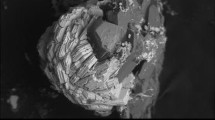Summary
Fourier transform infrared (IR) spectroscopic investigations of precipitated carbonate apatites in thev 4 CO3 domain reveal the existence of five bands at 757, 740, 718, 692, 670 cm−1 which can be assigned to several distinct environments of the carbonate ion in the apatite structure. In order to identify these environments precisely, fluoridated and pure type A carbonate apatites (i.e., with carbonate ions in monovalent anionic sites) were examined. The bands at 670 and 757 cm−1 were attributed to type A carbonate and their relative intensity was found to increase when the carbonate content of the apatite diminished or when samples were heated at 400°C. Fluoridated apatites show only two bands, close to 718 and 693 cm−1, corresponding to type B carbonate ions (carbonate in trivalent anionic sites). The band at 740 cm−1 was revealed by heating the samples to 400°C. This is due to OH ions' hydrogen bonded to fluoride and to carbonate ions in an undertermined apatite site. Despite the low intensity of IR bands, investigations in thev 4 CO3 domain appear complementary to those in other carbonate vibrational domains and could be useful for a more precise identification of bone mineral.
Similar content being viewed by others
References
Okazaki M (1983) Fluoride ion-carbonate ion interaction in the IR spectra of fluridated carbonate apatite. Calcif Tissue Int 35:78–81
LeGeros RZ, Trautz OR, LeGeros JP, Klein E (1968) Carbonate substitution in the apatitic structure. Bull Soc Chim Fr (special issue) 1712–1718
Elliott JC, Holcomb DW, Young RA (1985) Infrared determination of the degree of substitution of hydroxyl by carbonate ions in human dental enamel. Calcif Tissue Int 37:372–375
Termine JD, Lundy DR (1973) Hydroxide and carbonate in rat bone mineral and its synthetic analogues. Calcif Tissue Res 13:73–82
Nelson DGA, Williamson BE (1982) Low-temperature laser Raman spectroscopy of synthetic carbonated apaties and dental enamel. Aust J Chem 35:715–727
Vignoles M, Bonel G, Holcomb DW, Young RA (1988) Influence of preparation conditions on the composition of type B carbonated hydroxyapatite and on the localization of the carbonate ions. Calcif Tissue Int 43:33–40
Trombe JC, Bonel G, Montel G (1969) Etude par spectrométrie d'absorption infrarouge de l'ion carbonate dans quelques apatites préparées à haute température. CR Acad Sci Paris 268:941–944
Rey C, Collins B, Goehl T, Dickson IR, Glimcher MJ (1989) The carbonate environment in bone mineral: a resolution-enhanced Fourier transform infrared spectroscopy study. Calcif Tissue Int 45:157–164
Roux P, Bonel G (1980) Evolution structurale sous haute pression des apatites carbonatées de type B. Ann Chim Fr 5:397–405
Baxter JD, Biltz RM, Pellegrino ED (1966) The physical state of bone carbonate: a comparative infrared study in several mineralized tissues. Yale J Biol Med 3:456–470
LeGeros RZ (1967) Crystallography studies of the carbonate substitution in the apatite structure. PhD thesis, New York University. New York
Marraha M (1989) Synthèse et étude physico-chimique des phospho-sulfates de calcium de structure β Ca3(PO4)2. Thèse d'Etat, INP, Toulouse
Charlot G (1966) Les méthodes de la chimie analytique, analyse quantitative et minérale, 5ème ed. Masson, Paris
Pinta M (1971) Spectrométrie d'absorption atomique, t. 1 et 2, Masson, Paris
Edmond CR (1969) Direct determination of fluoride in phosphate rock samples using the specific ion electrod. Anal Chem 41:1327–1328
Hannah RN, Swinehart JS (1974) Experiments in techniques of infrared spectroscopy. Perkin-Elmer Norwalk, Conn
Kaupinen JK, Moffatt DJ, Mantsch HH, Cameron DG (1981) Fourier self-deconvolution: a method for resolving intrinsically overlapped bands. App Spect 35:271–276
Herzberg G (1945) Infrared and Raman spectra of polyatomic molecules. D Van Nostrand Co, London, p 298
Flowler BO (1974) Infrared studies of apatites. I. Vibrational assignments for calcium, strontium, and barium hydroxyapatite utilizing isotopic substitution. Inorg Chem 13:194–207
Gree A, Dietz VR (1955) Pyrophosphate formation upon ignition of precipitated basic calcium phosphate. J Am Chem Soc 77:2961–2965
Bonel G, Labarthe JC, Vignoles C (1973) Contribution à l'étude structurale des apatites carbonatées de type B. Colloque International CNRS (Paris) Physico-Chimie et Cristallographie des apatites d'intérêt biologique 230:117–125
Beshah K, Rey C, Glimcher MJ, Shimizu M, Griffin RG (1990) Carbon-13 and proton solid-state NMR studies of carbonate-containing calcium phosphates and enamel. J Solid State Chem 84:71–81
McConnel D (1952) The problem of the carbonate apatites. IV. Structural substitutions involving CO3 and OH. Bull Soc Fr Miner Crystallog 75:428–445
Trombe JC (1972) Contribution à l'étude de la décomposition et de la réactivité de certaines apatites hydroxylées carbonatées ou fluorées alcalino-terreuses. Thèse d'Etat Université Paul Sabatier, Toulouse
Holcomb DW, Young RA (1980) Thermal decomposition of human tooth enamel. Calcif Tissue Int 31:189–201
Vignoles-Montrejaud M (1984) Contribution á l'étude des apatites carbonatées de type B. Thèse d'Etat, INP, Toulouse
ElFeki H, Jemal M (1989) Methode gravimetrique de dosage des carbonates dans les apatites. Analusis 17, 8:460–463



